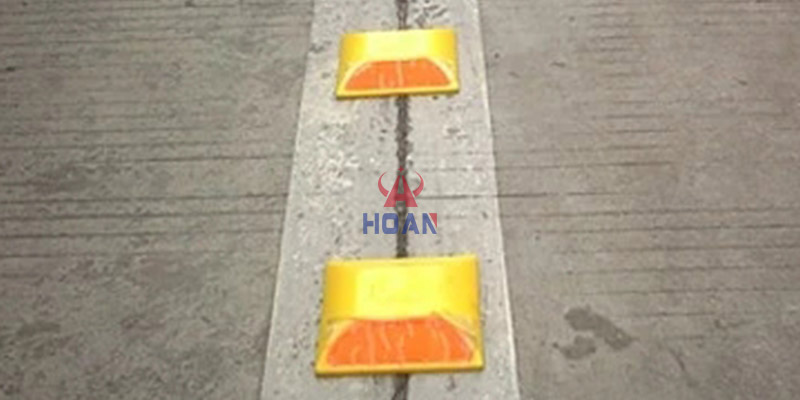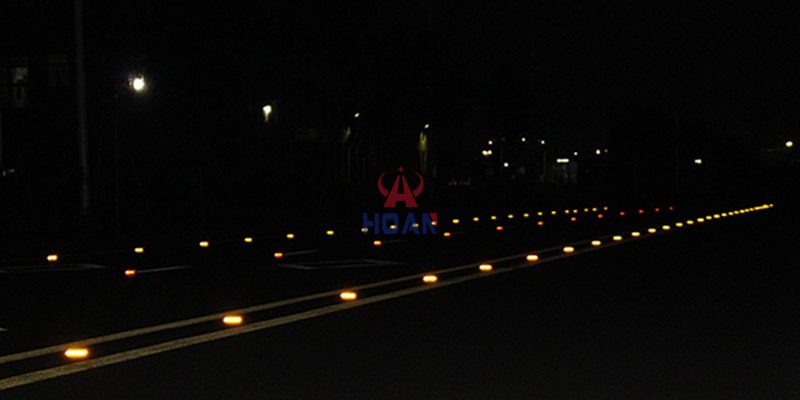In the field of road safety infrastructure, road studs, despite their small size, play an indispensable role. They clearly mark road boundaries, guide traffic flow, and enhance road visibility in low-light conditions, making them an essential component of modern transportation infrastructure. As global emphasis on road safety continues to grow, various types of road stud products have emerged. Among these, plastic reflective road studs, with their unique advantages, have become a popular choice for many road projects.
Plastic reflective road studs are made from high-quality engineering plastics such as ABS and polycarbonate, resulting in a weight reduction of 30%–50% compared to metal road studs. For example, a single standard-sized plastic road stud weighs approximately 0.5 kilograms, while a metal road stud of the same specifications can weigh over 1 kilogram.
This lightweight characteristic significantly reduces transportation and installation difficulties. During road construction, workers can more conveniently transport and install them, greatly saving labour costs and construction time. Additionally, engineering plastics possess excellent toughness and strength, capable of withstanding repeated rolling by heavy vehicles and collisions during daily use without breaking or deforming, with a service life of 5–8 years.
Plastic reflective road studs have inherent corrosion resistance advantages and do not rust like metal studs. In coastal areas, high salt content in the air accelerates corrosion of metal studs, but plastic studs maintain stable performance. In northern regions where de-icing salt is frequently used in winter, plastic studs are not damaged by chemical corrosion.
Additionally, plastic track spikes demonstrate exceptional weather resistance. Whether in desert regions with temperatures as high as 50°C or in frigid areas as low as -30°C, they maintain excellent physical properties. Even under extreme weather conditions such as heavy rain or snow, their structure remains intact without failing due to thermal expansion/contraction or water erosion, ensuring reliable long-term performance.
From a cost perspective, plastic reflective track spikes are highly competitive. Their raw material costs and production processes are relatively simple, resulting in an initial purchase price that is 20%–30% lower than that of metal track spikes.
During long-term use, the maintenance cost advantage of plastic road studs becomes even more evident. Due to their corrosion resistance and weather resistance, the replacement frequency is significantly reduced, with average annual maintenance costs being less than half of those for metal road studs. Considering both initial investment and long-term maintenance, plastic road studs can save a significant amount of funds for road construction and management departments.

Plastic reflective track spikes are equipped with high-reflective materials such as glass microspheres or microprism reflective films. When vehicle headlights illuminate them, glass microspheres use refraction and reflection principles to concentrate light back toward the light source; microprism reflective films utilise total reflection properties to achieve more efficient light reflection.
In nighttime or adverse weather conditions such as heavy fog or rain, these reflective materials ensure the studs remain clearly visible from 300 metres away, providing drivers with ample reaction time. Professional testing shows that high-quality plastic road studs achieve reflective intensities of 200–500 cd/lx/m², far exceeding national standard requirements.
Plastic reflective road studs offer multiple colour options, including common colours such as white, yellow, red, and blue. White road studs are commonly used for lane separation lines to clearly define driving areas; yellow road studs are used for warning zones to alert drivers to potential hazards; red road studs can be used for no-entry zones; and blue road studs can be used for special-purpose roads or areas.
Additionally, depending on project requirements and local traffic regulations, the colours and appearance of the studs can be customised. Whether adding specific symbols, patterns, or adjusting colour combinations, these studs can meet diverse road safety design requirements.
The installation process for plastic reflective road studs is simple and quick, primarily using two methods: adhesive bonding or mechanical fixation. When using adhesive bonding, simply clean the road surface, apply special adhesive, and press the road stud into place. The installation time for a single road stud does not exceed 2 minutes.
Their lightweight and compact design makes them suitable for various road surface materials such as asphalt and concrete, and they can even be quickly installed on temporary roads or construction access roads. For road areas requiring frequent adjustments or re-layout, the convenient installation characteristics of plastic road studs offer significant advantages.
Maintenance of plastic reflective road studs is extremely simple. Routine maintenance only requires regular cleaning of surface dust, dirt, oil stains, and other debris to maintain optimal reflective performance. Due to their durable material, they typically do not require frequent replacement under normal conditions, reducing the workload and maintenance frequency for road maintenance personnel.
In contrast, metal road studs may require more frequent inspections and repairs due to issues like rusting or loosening, while ceramic road studs may be prone to breakage due to their brittle nature. The low-maintenance characteristics of plastic road studs save road management departments a significant amount of human and material resources.
Plastic reflective road studs are suitable for various road scenarios. On highways, they are used to clearly demarcate lanes and prevent accidents caused by vehicles changing lanes arbitrarily; in urban roads, they assist traffic signals and markings to manage complex vehicle and pedestrian flows; on rural roads, they provide necessary road guidance for vehicles driving at night; in parking lots and pedestrian crossing areas, they regulate parking order and ensure pedestrian safety.
Whether on major roads with heavy traffic or minor roads with lighter traffic, plastic road studs can be flexibly applied according to actual needs, effectively enhancing road safety levels.
Plastic reflective road studs can seamlessly integrate with other safety facilities such as road markings, traffic signs, and guardrails. When used in conjunction with road markings, they enhance the nighttime visibility of the markings; when placed near traffic signs, they further guide drivers to pay attention to the sign information; when used with guardrails, they clearly define the road edges to prevent vehicles from veering off the road.
Through the coordinated operation of multiple safety facilities, plastic road studs help build a comprehensive and efficient road safety system, significantly enhancing traffic management effectiveness and safety protection capabilities.
In a highway expansion and renovation project in a certain province, plastic reflective road studs were used to replace the original metal road studs. After the renovation, the nighttime accident rate on that section of the road decreased by 40%, and drivers generally reported that the road boundaries were clearer and their sense of driving safety was significantly improved.
In a road renovation project in an old residential community, plastic road studs of different colours were installed to redefine parking areas, pedestrian pathways, and vehicle routes, effectively improving traffic order within the community and reducing resident complaints by 60%.
A manager from a municipal road management department stated: ‘Plastic road studs are easy to install, simple to maintain, and their reflective performance remains consistently stable, saving us significant costs and effort.’
A project manager from a road construction company also mentioned: ‘After using plastic road studs in multiple projects, clients were highly satisfied with the road safety outcomes, which also enhanced our company's project reputation.’

Compared to metal road studs, plastic road studs are lightweight, easy to install, and do not rust or corrode. While metal road studs have higher strength, they are prone to rusting over time, which affects reflective performance and service life, and also incurs higher maintenance costs. In projects with high requirements for cost and installation convenience, plastic road studs offer a clear advantage.
Ceramic road studs have excellent reflective performance but are brittle and prone to damage under strong impact, and they are relatively expensive. Plastic road studs combine good reflective performance with flexibility and cost-effectiveness, making them a more practical choice for most standard road scenarios.
Plastic reflective road studs, with their lightweight, durable, corrosion-resistant, and cost-effective material properties, excellent optical performance, convenient installation and maintenance methods, and broad application scenario adaptability, are an ideal choice in the field of road safety facilities. Their good compatibility with other safety facilities further enables them to play a crucial role in constructing comprehensive road safety systems.For road construction professionals, traffic engineers, and project managers, plastic reflective road studs are undoubtedly an excellent solution for enhancing road safety. For more product information or customised solutions, please contact our professional team to collaborate on creating a safer and more efficient road traffic environment.